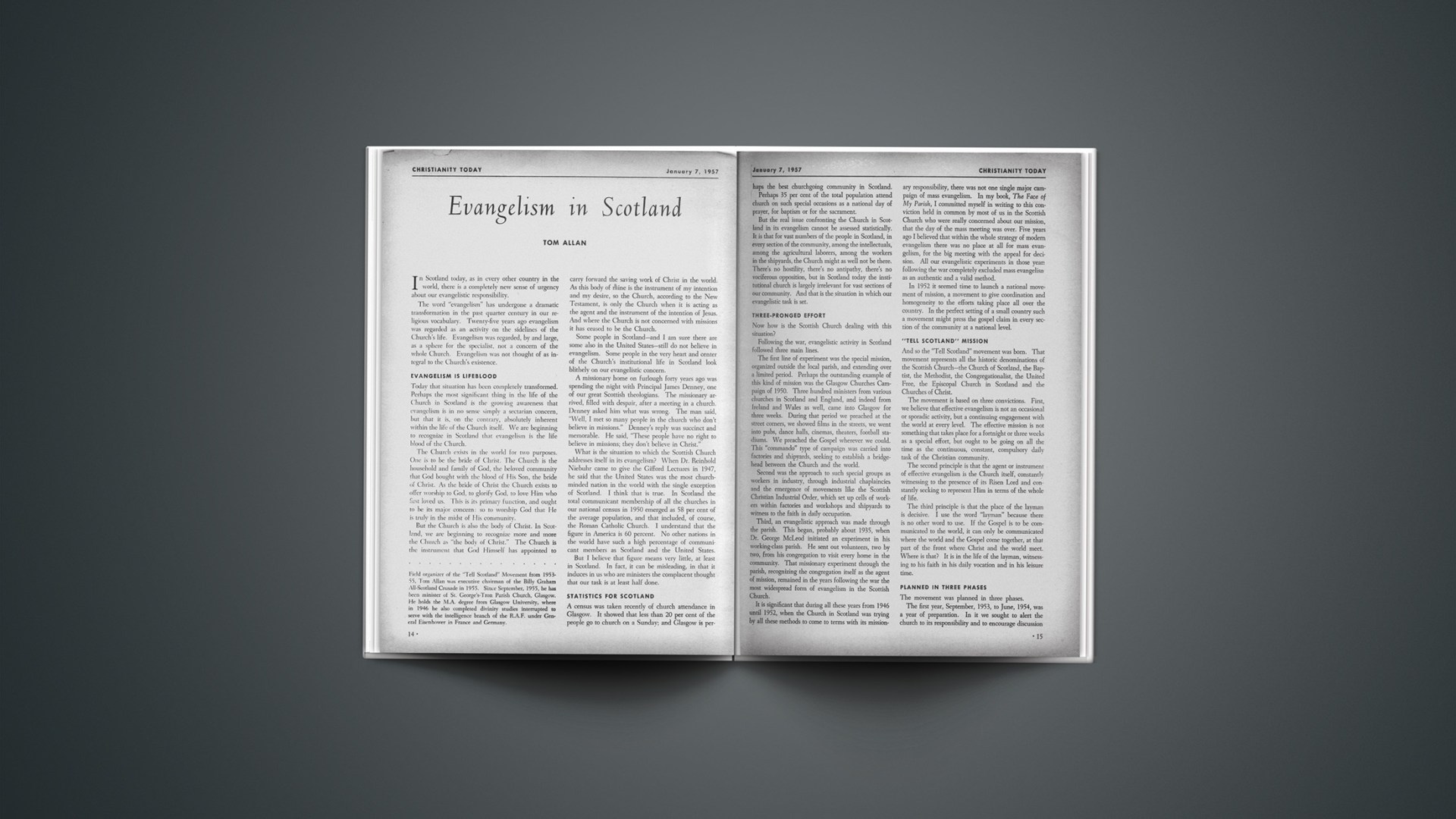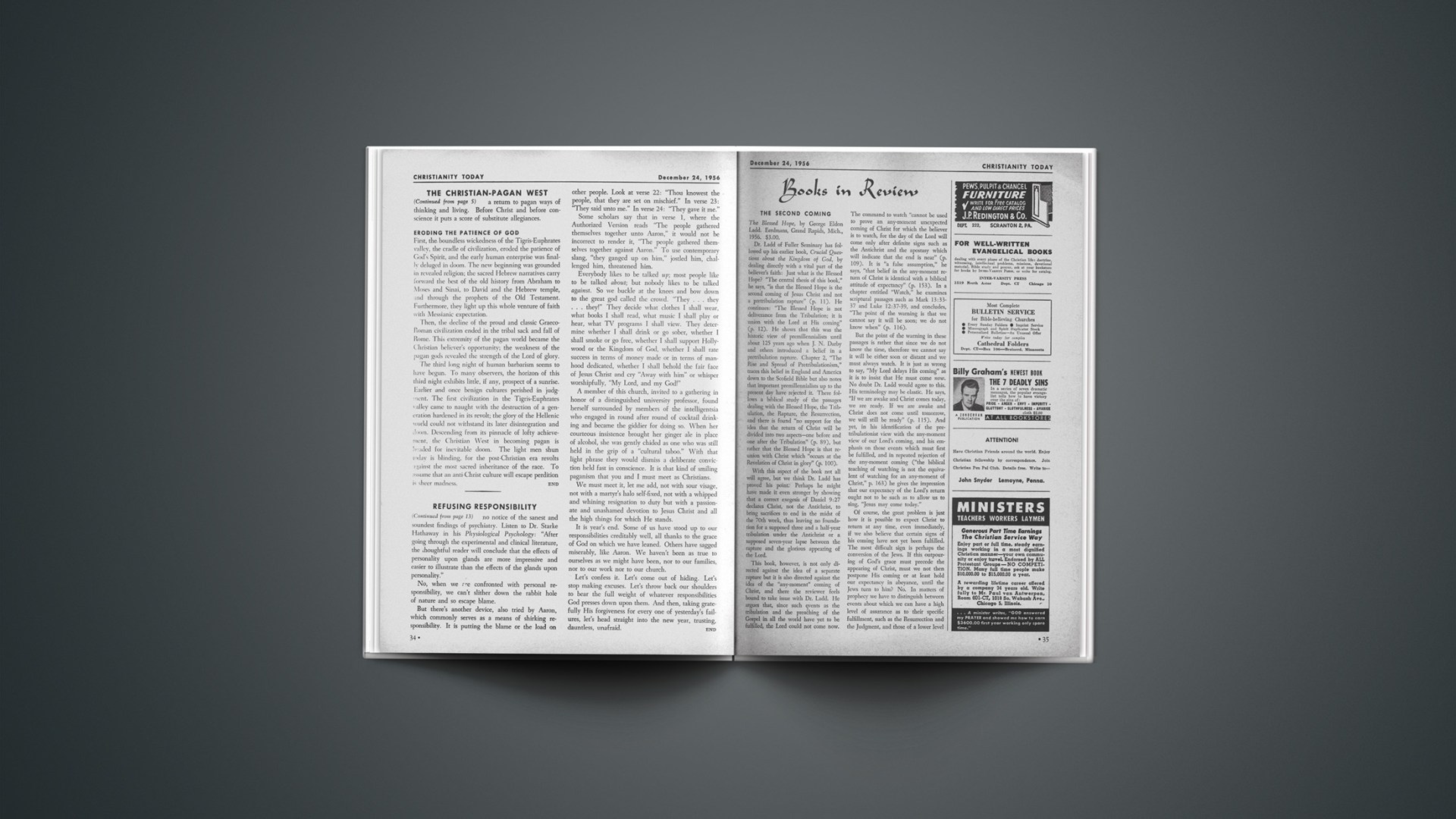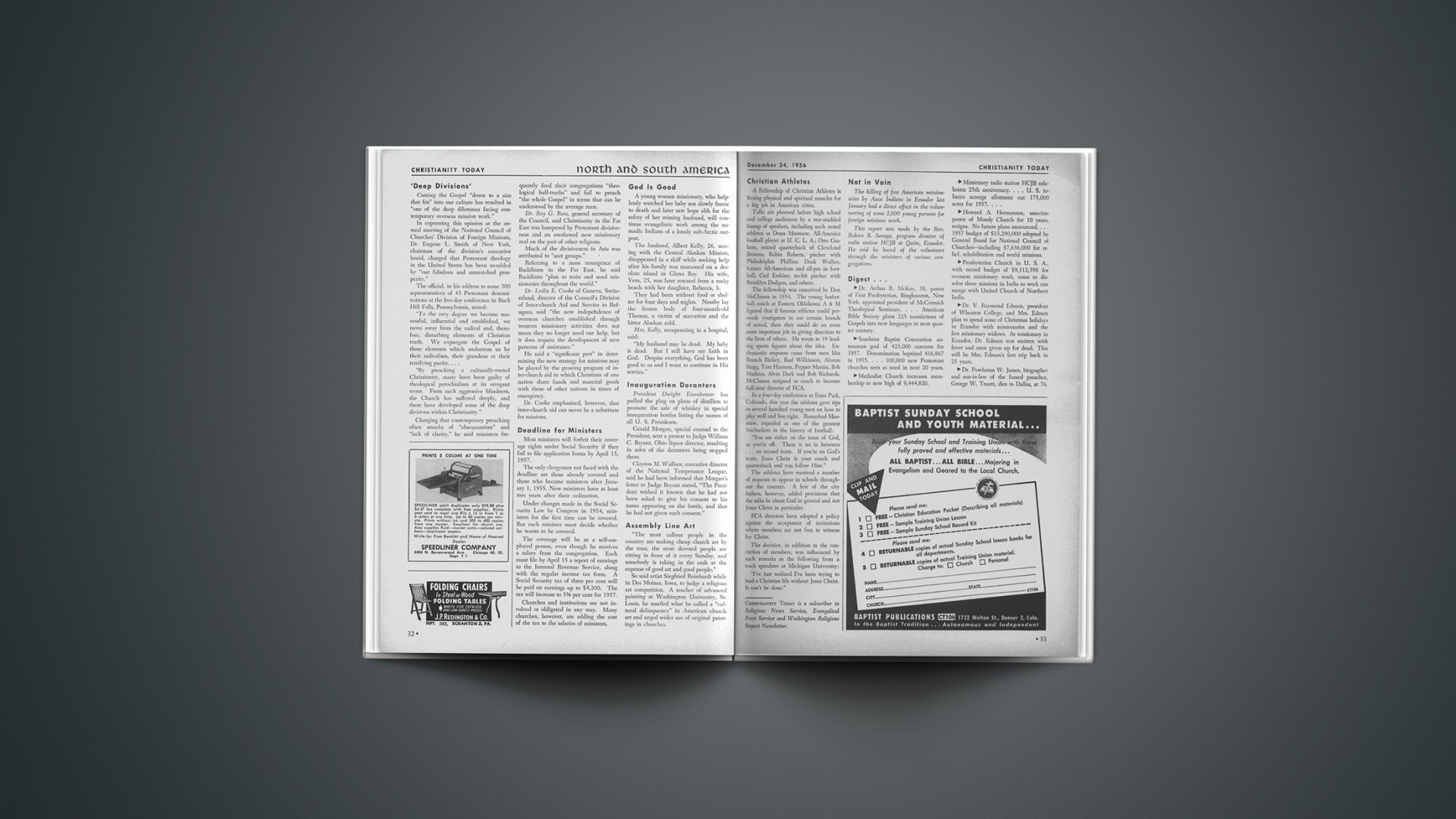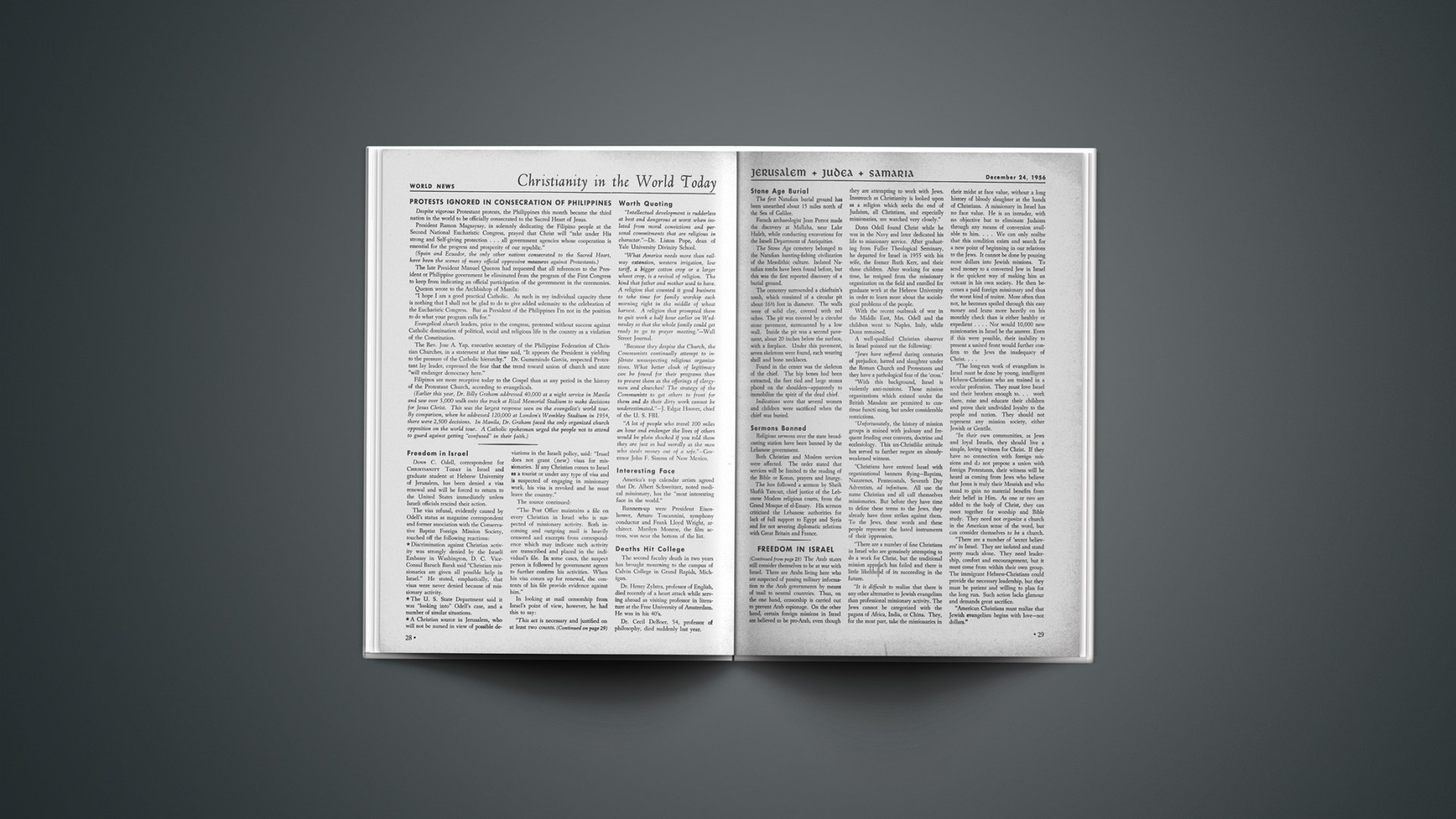In Scotland today, as in every other country in the world, there is a completely new sense of urgency about our evangelistic responsibility.
The word “evangelism” has undergone a dramatic transformation in the past quarter century in our religious vocabulary. Twenty-five years ago evangelism was regarded as an activity on the sidelines of the Church’s life. Evangelism was regarded, by and large, as a sphere for the specialist, not a concern of the whole Church. Evangelism was not thought of as integral to the Church’s existence.
Evangelism Is Lifeblood
Today that situation has been completely transformed. Perhaps the most significant thing in the life of the Church in Scotland is the growing awareness that evangelism is in no sense simply a sectarian concern, but that it is, on the contrary, absolutely inherent within the life of the Church itself. We are beginning to recognize in Scotland that evangelism is the life blood of the Church.
The Church exists in the world for two purposes. One is to be the bride of Christ. The Church is the household and family of God, the beloved community that God bought with the blood of His Son, the bride of Christ. As the bride of Christ the Church exists to offer worship to God, to glorify God, to love Him who first loved us. This is its primary function, and ought to be its major concern: so to worship God that He is truly in the midst of His community.
But the Church is also the body of Christ. In Scotland, we are beginning to recognize more and more the Church as “the body of Christ.” The Church is the instrument that God Himself has appointed to carry forward the saving work of Christ in the world. As this body of mine is the instrument of my intention and my desire, so the Church, according to the New Testament, is only the Church when it is acting as the agent and the instrument of the intention of Jesus. And where the Church is not concerned with missions it has ceased to be the Church.
Some people in Scotland—and I am sure there are some also in the United States—still do not believe in evangelism. Some people in the very heart and center of the Church’s institutional life in Scotland look blithely on our evangelistic concern.
A missionary home on furlough forty years ago was spending the night with Principal James Denney, one of our great Scottish theologians. The missionary arrived, filled with despair, after a meeting in a church. Denney asked him what was wrong. The man said, “Well, I met so many people in the church who don’t believe in missions.” Denney’s reply was succinct and memorable. He said, “These people have no right to believe in missions; they don’t believe in Christ.”
What is the situation to which the Scottish Church addresses itself in its evangelism? When Dr. Reinhold Niebuhr came to give the Gifford Lectures in 1947, he said that the United States was the most church-minded nation in the world with the single exception of Scotland. I think that is true. In Scotland the total communicant membership of all the churches in our national census in 1950 emerged as 58 per cent of the average population, and that included, of course, the Roman Catholic Church. I understand that the figure in America is 60 percent. No other nations in the world have such a high percentage of communicant members as Scotland and the United States.
But I believe that figure means very little, at least in Scotland. In fact, it can be misleading, in that it induces in us who are ministers the complacent thought that our task is at least half done.
Statistics For Scotland
A census was taken recently of church attendance in Glasgow. It showed that less than 20 per cent of the people go to church on a Sunday; and Glasgow is perhaps the best churchgoing community in Scotland.
Perhaps 35 per cent of the total population attend church on such special occasions as a national day of prayer, for baptism or for the sacrament.
But the real issue confronting the Church in Scotland in its evangelism cannot be assessed statistically. It is that for vast numbers of the people in Scotland, in every section of the community, among the intellectuals, among the agricultural laborers, among the workers in the shipyards, the Church might as well not be there. There’s no hostility, there’s no antipathy, there’s no vociferous opposition, but in Scotland today the institutional church is largely irrelevant for vast sections of our community. And that is the situation in which our evangelistic task is set.
Three-Pronged Effort
Now how is the Scottish Church dealing with this situation?
Following the war, evangelistic activity in Scotland followed three main lines.
The first line of experiment was the special mission, organized outside the local parish, and extending over a limited period. Perhaps the outstanding example of this kind of mission was the Glasgow Churches Campaign of 1950. Three hundred ministers from various churches in Scotland and England, and indeed from Ireland and Wales as well, came into Glasgow for three weeks. During that period we preached at the street corners, we showed films in the streets, we went into pubs, dance halls, cinemas, theaters, football stadiums. We preached the Gospel wherever we could. This “commando” type of campaign was carried into factories and shipyards, seeking to establish a bridgehead between the Church and the world.
Second was the approach to such special groups as workers in industry, through industrial chaplaincies and the emergence of movements like the Scottish Christian Industrial Order, which set up cells of workers within factories and workshops and shipyards to witness to the faith in daily occupation.
Third, an evangelistic approach was made through the parish. This began, probably about 1935, when Dr. George McLeod initiated an experiment in his working-class parish. He sent out volunteers, two by two, from his congregation to visit every home in the community. That missionary experiment through the parish, recognizing the congregation itself as the agent of mission, remained in the years following the war the most widespread form of evangelism in the Scottish Church.
It is significant that during all these years from 1946 until 1952, when the Church in Scotland was trying by all these methods to come to terms with its missionary responsibility, there was not one single major campaign of mass evangelism. In my book, The Face of My Parish, I committed myself in writing to this conviction held in common by most of us in the Scottish Church who were really concerned about our mission, that the day of the mass meeting was over. Five years ago I believed that within the whole strategy of modern evangelism there was no place at all for mass evangelism, for the big meeting with the appeal for decision. All our evangelistic experiments in those years following the war completely excluded mass evangelism as an authentic and a valid method.
In 1952 it seemed time to launch a national movement of mission, a movement to give coordination and homogeneity to the efforts taking place all over the country. In the perfect setting of a small country such a movement might press the gospel claim in every section of the community at a national level.
“Tell Scotland” Mission
And so the “Tell Scotland” movement was born. That movement represents all the historic denominations of the Scottish Church—the Church of Scotland, the Baptist, the Methodist, the Congregationalist the United Free, the Episcopal Church in Scotland and the Churches of Christ.
The movement is based on three convictions. First, we believe that effective evangelism is not an occasional or sporadic activity, but a continuing engagement with the world at every level. The effective mission is not something that takes place for a fortnight or three weeks as a special effort, but ought to be going on all the time as the continuous, constant, compulsory daily task of the Christian community.
The second principle is that the agent or instrument of effective evangelism is the Church itself, constantly witnessing to the presence of its Risen Lord and constantly seeking to represent Him in terms of the whole of life.
The third principle is that the place of the layman is decisive. I use the word “layman” because there is no other word to use. If the Gospel is to be communicated to the world, it can only be communicated where the world and the Gospel come together, at that part of the front where Christ and the world meet. Where is that? It is in the life of the layman, witnessing to his faith in his daily vocation and in his leisure time.
Planned In Three Phases
The movement was planned in three phases.
The first year, September, 1953, to June, 1954, was a year of preparation. In it we sought to alert the church to its responsibility and to encourage discussion of the evangelistic theme among responsible laity throughout the whole Church.
The second phase, from September, 1954, until June, 1955, we called recruiting the laity. This was directed toward recruiting the lay forces of the Scottish Church. The movement was to express itself through the witness of small groups of lay people in their own congregations, witnessing to their faith in the local situation.
Anxieties Over Graham
Into that situation Dr. Billy Graham came to Scotland, in the year of recruitment. When it was suggested that Dr. Graham might come to Scotland there was much hesitation. There were reservations about certain aspects of Dr. Graham’s theology in many sections of the Scottish church. Primarily, there was an honest concern lest the Crusade, with its inevitable appeal to the national press and with its spectacular appeal to the whole nation, would irrevocably damage the central point of the “Tell Scotland” movement, which is the quiet, unspectacular and yet crucial preparation of each congregation for its own mission. There was much discussion.
After much talk and a great deal of prayer, the steering panel unanimously sent the invitation to Dr. Graham to conduct his Glasgow Crusade.
Since The Reformation
It was my privilege to act as chairman of the Executive Committee of that crusade in Glasgow. Five years ago I did not believe that mass evangelism was relevant within the context of modern missions. Twelve months after the crusade, after the closest study of the situation in Scotland and after the closest possible intimacy with Dr. Graham and his work while he was in Glasgow, it is my own absolute conviction that perhaps nothing has made a deeper mark on the religious and secular life of the Scottish nation since the Reformation than Dr. Graham’s crusade last year.
The thrilling story of that crusade includes the thousands of people who came night by night and twenty-five thousand people who during that time found new life in Christ or found reconsecration.
The crusade came in the second phase of “Tell Scotland,” and we were very worried about its coming. We were seeking to recruit the lay forces of the church for the unspectacular, quiet, humble witness of the laymen within their own situation, and we wondered how the crusade would affect us.
Results Of The Crusade
The crusade did these things for Scotland: First, it reminded us of the true aim of evangelism, by confronting us with that perpetual mystery of the power of God in Christ to change and transform a man’s life. Second, it reaffirmed the central message of evangelism, the unchanging good news that God was in Christ reconciling the world unto Himself. Third, it underlined the essential conditions of evangelism, faithful and expectant prayer and the unity of God’s people. Fourth, it reasserted a powerful method of evangelism, the mass meeting with the simple proclamation of the Word of God.
What happened as a result of the crusade? I know a congregation whose minister had tried for five years to get a group of lay people in his church to undertake the work of the “Tell Scotland” Movement in his own parish. He preached about it; he appealed to his people to come for prayer, for Bible study, for witness in their own situation. He couldn’t even get the session in the congregation to move. We were in the second phase of “Tell Scotland,” to recruit the lay people, but he couldn’t recruit his own members, and I know scores of ministers in Scotland who were in precisely that situation. Men were committed heart and soul to “Tell Scotland,” but couldn’t find the response from the pew that is essential if we’re going to bridge the gap between the church and the world.
On The Last Sunday
The last Sunday of the crusade, this minister asked those in his congregation who had been deeply moved and challenged by the crusade—and this was unprecedented in this church—to rise in their places. In that select, exclusive, west-end church, a hundred men and women stood up. “Now,” he said, “I want you people to join me in becoming the agents of mission in this parish. If you are prepared, go home and write me a post card and tell me that you will be here Wednesday night to begin with me to study our responsibility in the world.” By Tuesday he had seventy-eight post cards. Today in that church there is a dynamic group of lay people who are translating the faith into practice in their own parish.
Mission Of Visitation
And so we have reached the third phase of “Tell Scotland,” the outgoing, the outreach of these lay groups throughout the country. During the last winter, 800 missions of visitation were in process throughout the whole of Scotland. I personally have knowledge of some 900 lay groups that are meeting week by week with their minister for prayer, for Bible study and to prepare and equip themselves for the work of witness in their own parishes. We are seeking thus to Tell Scotland, and our prayer, as it was the prayer of John Knox is, “Lord, give me Scotland, or I die.”
Field organizer of the “Tell Scotland” Movement from 1953–55, Tom Allan was executive chairman of the Billy Graham All-Scotland Crusade in 1955. Since September, 1955, he has been minister of St. George’s-Tron Parish Church, Glasgow. He holds the M.A. degree from Glasgow University, where in 1946 he also completed divinity studies interrupted to serve with the intelligence branch of the R.A.F. under General Eisenhower in France and Germany.












